The Last Mile
Posted On Wednesday, Mar 20, 2024
With some initial success in bringing down inflation, several central banks have now shifted their focus to the ‘last mile’ of inflation. Many consider it to be the most difficult part of the journey.
In Indian context, the last mile refers to getting the CPI inflation to 4% and keeping it there. For now, the headline CPI inflation is far from this goal. As per the latest release for February 2024, the headline CPI inflation stands at 5.09%.
This is keeping the RBI on cautious footing as they kept policy rates on hold for more than a year now despite inflation cooling off meaningfully from its peak. This can be observed in the RBI governor’s statement as well when he said – “We must remain committed to successfully navigating the ‘last mile’ of disinflation which can be sticky”.
Apart from the ‘last mile of disinflation’, the RBI also seems to be worried about potential market reaction to any change in policy tone. He noted in the minutes of the last MPC meeting – “As markets are front-running central banks in anticipation of policy pivots, any premature move may undermine the success achieved so far”. Perhaps for this reason, the RBI is wary of easing its stance on inflation.
In this note, we will take a closer look at the anatomy of inflation and gauge its potential impact on the future monetary policy and investor expectations in the bond market.
Anatomy of Inflation
We had explored the inflation dynamics in a greater detail about same time last year (Positioning for Disinflation – January 2023; Past, Present, and Future of Inflation – February 2023) and had presented a case for continued disinflation.
Since then, the headline CPI inflation has declined by 135 basis points from 6.44% in February 2023 to 5.09% in February 2024. Despite this good-sized drop in inflation, the true extent of disinflation is under-estimated in the headline CPI numbers.
This is mainly due to high and volatile vegetable prices which have faced multiple supply shocks over the last few cropping seasons. Given the volatile nature of vegetable prices in India, it is critical to look at ex-vegetable inflation to gauge the underlying inflation trend, particularly in the context of monetary policy.
The Vegetable sub-index constitutes 6.04% of the CPI basket. However, it is contributing more than 25% of the total year-over-year (YoY) increase in the CPI index in the last three months.
The CPI ex-vegetable which captures around 94% of the total CPI basket, grew merely 3.77% YoY in February 2024 as against the headline CPI inflation of 5.09% YoY.
On month-on-month basis, the CPI ex-vegetable index grew by 0.2% in February. This translates to an annualized inflation rate of 2.5%.
A similar trend can be observed across most of the goods and services in the CPI basket - showing underlying inflation momentum close 2%-3% on annualised basis.
Chart – I: Underlying inflation trending below 4% while the Headline CPI remaining elevated due to volatile vegetable index
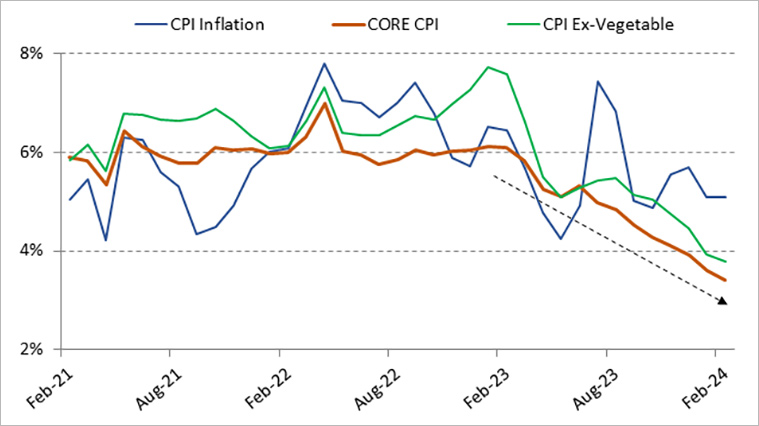
Source – MOSPI, Quantum Research; Data upto February 2024
Implication for Monetary Policy
Should the RBI consider the CPI inflation ex-vegetable or be anchored to the headline inflation? – can be an open debate.
For now, the RBI seemed more worried about repeated food price shocks and a risk of high food inflation getting generalised and pulling up non-food inflation too.
Given the household inflation expectation is predominantly based on food inflation, this risk is real. We have explored this argument many times in past (Good Time to Be Bond Investor) and concluded that there is no evidence of food inflation getting generalised for now.
Despite elevated food prices, inflation expectations of Indian households have been very well anchored. As per the RBI’s inflation expectation survey, households’ perception of current inflation and expectations of future inflation have been coming down consistently.
Chart – V: Despite elevated food inflation, household inflation expectation is very well anchored
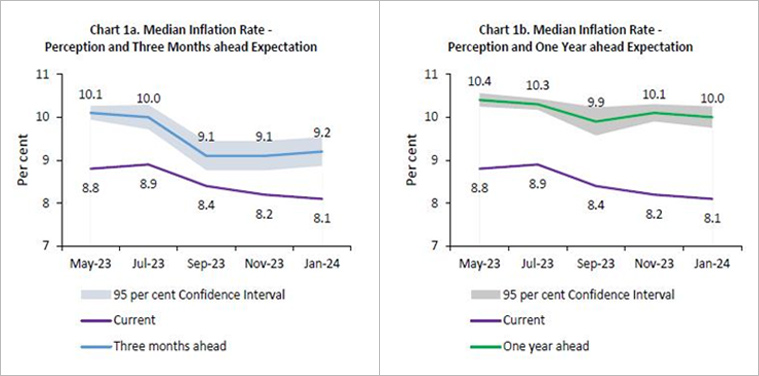
Source – RBI Households’ Inflation Expectation Survey, February 2024
Given the weak employment situation, declining fiscal support for household sector and sluggish consumption demand outlook, we see increased probability of core inflation (ex-food and fuel) going down in future.
Based on the current trend, the core CPI is likely to remain below 3.5% in FY25. In our opinion, the headline CPI will converge to the core inflation trend over medium term. We see high probability of downward surprise to the RBI’s 4.5% CPI inflation estimate for FY25.
Let’s get to the point. Will the RBI cut rate?
As far as monetary policy is concerned, inflation is not the only factor driving the rate decision. The RBI seems comfortable or rather bullish on the growth outlook. So, there is no urgent need for rate cut to support growth.
While on the other hand, having real interest rates too high (interest rates minus inflation) will not provide any added strength to the economy. Instead, high real interest rates can induce fragility in the financial system and broader economy if persist for long. Some learnings can be drawn from the period of high real interest rate between 2016-19 when economic growth slowed down very sharply in 2019 following the extended period of high real interest rates.
With underlying inflation running below 4% (ex-vegetable), there is a room to cut interest rates by 50-100 basis points. Most of it will probably come during the second half of FY25.
Chart – III: Real Repo Rate is near 2% - presenting case for Rate Cuts
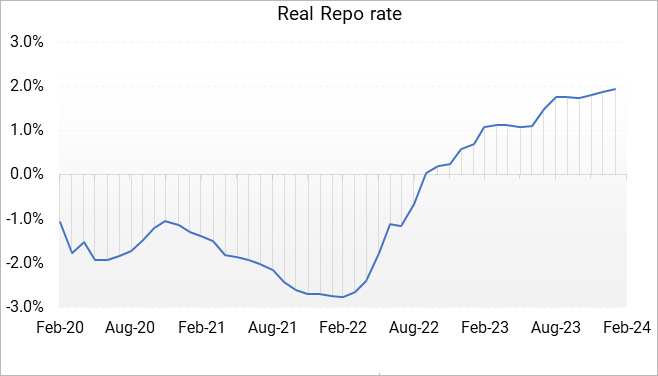
Source – Refinitiv, MOSPI, Quantum Research; Data Upto February 29, 2024
Real Policy Rate = Repo Rate – average CPI for forward 12 months. Real Rate from March 2023 to February 2024 includes Quantum Research Team’s estimates of forward CPI.
Past performance may or may not sustain in future
Bull case for Bonds
In most times, bond yields (interest rates) have direct linkages with inflation. With inflation coming down, bond yields should also go down. However, there are confluence of other positive drivers supporting the bond market, as we have been highlighting for some time now (The Bull Case).
We expect bond yields to do down from current levels supported by falling inflation, potential rate cuts in India and globally, favourable demand supply dynamics and global bond index inclusion.
What should Investors do?
Considering a strong case for long term yields to decline over the next 1-2 years backed by the reasons described above, we believe long term government bonds offer a rewarding opportunity.
Dynamic Bond Funds are probably best placed to capture this opportunity with a flexibility to change if things don’t pan out as expected. However, investors need to have a longer holding period of at-least 2-3 years to ride through the intermittent volatility.
Investors with shorter investment horizons and low-risk appetites should stick with liquid funds.
Portfolio Positioning
Scheme Name | Investment Approach |
The scheme invests in debt securities of up to 91 days of maturity issued by the government and selected public sector companies. | |
The scheme to invest in debt securities issued by the government and selected public sector companies. The scheme follows an active duration management strategy and increases/decreases the portfolio duration (sensitivity to interest rates changes) in accordance with the Interest Rate Outlook. Given our positive view on the bond market, we are maintaining reasonably high duration in the scheme with bulk of the assets in 10-14 year maturity bucket. |
Source – Refinitiv, MOSPI, Quantum Research, RBI, Bloomberg
For any queries directly linked to the insights and data shared in the newsletter, please reach out to the author – Pankaj Pathak, Fund Manager – Fixed Income at [email protected].
For all other queries, please contact Neeraj Kotian – Area Manager, Quantum AMC at [email protected] / [email protected] or call him on Tel: 9833289034
Read our last few Debt Market Observer write-ups -
- Quantum Budget View: Fiscal Prudence over Populist Spending
Name of the Scheme | This product is suitable for investors who are seeking* | Riskometer |
Quantum Liquid Fund An Open-ended Liquid Scheme. A relatively low interest rate risk and relatively low credit risk. |
| 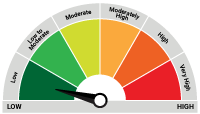 Investors understand that their principal will be at Low Risk |
Quantum Dynamic Bond Fund An Open-ended Dynamic Debt Scheme Investing Across Duration. A relatively high interest rate risk and relatively low credit risk. |
| 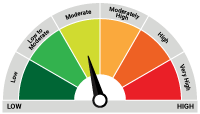 Investors understand that their principal will be at Moderate Risk |
* Investors should consult their financial advisers if in doubt about whether the product is suitable for them.
| Potential Risk Class Matrix – Quantum Dynamic Bond Fund | |||
Credit Risk → | Relatively Low | Moderate (Class B) | Relatively High (Class C) |
Interest Rate Risk↓ | |||
Relatively Low (Class I) | |||
| Moderate (Class II) | |||
| Relatively High (Class III) | A-III | ||
| Potential Risk Class Matrix – Quantum Liquid Fund | |||
Credit Risk → | Relatively Low | Moderate (Class B) | Relatively High (Class C) |
Interest Rate Risk↓ | |||
| Relatively Low (Class I) | A-I | ||
| Moderate (Class II) | |||
| Relatively High (Class III) | |||
Disclaimer, Statutory Details & Risk Factors:The views expressed here in this article / video are for general information and reading purpose only and do not constitute any guidelines and recommendations on any course of action to be followed by the reader. Quantum AMC / Quantum Mutual Fund is not guaranteeing / offering / communicating any indicative yield on investments made in the scheme(s). The views are not meant to serve as a professional guide / investment advice / intended to be an offer or solicitation for the purchase or sale of any financial product or instrument or mutual fund units for the reader. The article has been prepared on the basis of publicly available information, internally developed data and other sources believed to be reliable. Whilst no action has been solicited based upon the information provided herein, due care has been taken to ensure that the facts are accurate and views given are fair and reasonable as on date. Readers of this article should rely on information/data arising out of their own investigations and advised to seek independent professional advice and arrive at an informed decision before making any investments. Mutual fund investments are subject to market risks, read all scheme related documents carefully. |
Related Posts
-

The Pivot
Posted On Friday, Apr 21, 2023
The fiscal year 2022-23 has come to an end. The defining feature
Read More -

Yield Curve Inversion Ahead
Posted On Thursday, Mar 23, 2023
Indian money markets have tightened meaningfully over the last one and a half month.
Read More -

Past, Present, and Future of Inflation
Posted On Friday, Feb 24, 2023
Inflation has been one of the biggest challenges in the post-pandemic world.
Read More




